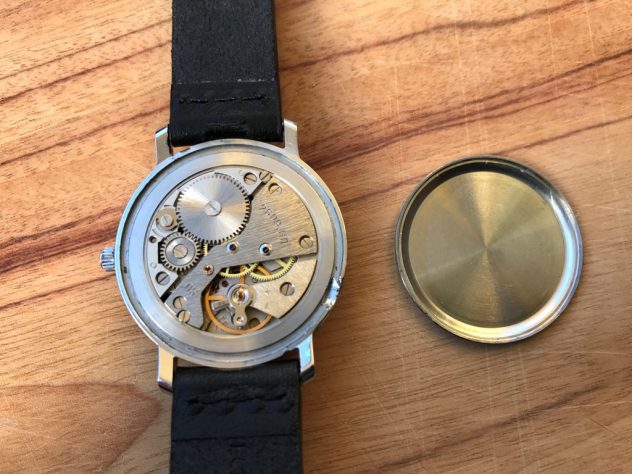When it comes to listing famous watchmaking countries, most people could name Switzerland, Japan and maybe Germany or France, if they had only a passing interest in watches. However there is one region that arguably surpasses those in terms of the level of fanaticism of its collectors, and that is the former Soviet Union.
Russia and the USSR have a rather rich horological history, with a large number of manufacturers in operation over quite a long period of time. What most of the brands lacked in high end mechanics and expensive hand-finishing compared to their European counterparts, they made up for with an astonishing array of unique designs, robustness and hearty doses of utilitarianism.
Soviet-era watches scored wins for the USSR during the Cold War too, as it was a Russian brand Strela (also known as Poljot) that was first wristwatch to be worn on a space walk; and Yuri Alexeyevich Gagarin’s Sturmanskie-branded piece that took the honours as the first watch actually taken up in orbit around the Earth.

Staying in space, Omega is of course famously associated with the Moon, touting their iconic and extremely successful Speedmaster as not only the “first watch to be worn on the moon” but more specifically “the first and only watch to be worn on the moon” (assuming you believe the moon landing actually happened….).
However, for this article I will discuss a Soviet watch linked to the Moon in very different way: the Raketa Kopernik.

Raketa, meaning ‘rocket’, is claimed to be a part of Russia’s oldest factory, the Petrodvorets Watch Factory founded in St Petersburg by Peter the Great in 1721. The Raketa brand first appeared in 1961/1962. During the era of the Soviet Union, Raketa primarily produced rugged watches for the mighty Soviet military (as did many other brands from the motherland), although mechanical timepieces for civilians were also produced in huge numbers.
The 1980s Raketa Kopernik is named in honour of Nicolaus Copernicus, the Renaissance-era Polish mathematician and astronomer who formulated a model of the universe that placed the Sun rather than the Earth at the centre of the universe. The unique design of the Kopernik represents the Sun and the Moon in a simplistic but clever way – the hour hand is a golden disc, being the Sun, and the minute hand is a black ring, being the Moon.

Hence this watch is also sometimes known as the ‘Sun and Moon watch’. Once an hour every hour, the hands momentarily overlap and effectively form an ‘eclipse’. This is one of those watches that you glance at not only to tell the time, but just to see if an ‘eclipse’ is imminent. The surface of the dial itself can be described as grainy (much like the surface of the moon perhaps?), and the golden applied hour markers catch the sun’s rays rather nicely indeed.

Beating away inside is Raketa’s own manually wound calibre 2609.HП, a reliable and accurate mass produced movement with an impressive 45 hour power reserve out of the factory.

The Raketa Kopernik, a real Soviet design classic, and worthy of being known as the other Moon Watch!
By Adam – Mechanical_Time : https://www.instagram.com/mechanical_time/

actually, this is kind of cool. any recommendations where to acquire one?
They can be found pretty easily on eBay in a wide range of versions. It pays to ask questions of the seller and ask for extra photos, especially of the movement. Another source can be the various online watch forums where fellow watch enthusiasts list pieces for sale or trade.
Thanks! I have been researching this one since I saw your article. I do believe I’ll get one, when I find the right one. I never really looked at vintage pieces much before, but now after some research, this hobby may take an unexpected turn.
That’s great to hear. I’d welcome you to the always interesting world of vintage watch collecting!
That’s Valentina Tereshkova you’ve got pictured there. First woman in space.
Hey! So I recently got one, its a remake from a website called http://www.sputnik1957.com. But I don’t know how to set the time on it! How would I do that?
I just got two from eBay.They’re on the way.
I am jealous! Best wishes.
In light of all the terrible things happening in Ukraine – wanted to share a link to a Ukrainian watch collector who loves Soviet era watches and could use the help of the community to help him stay afloat. Picked up a piece from the 1950s and it’s a stunning piece of craftsmanship that he was able to fix and put back together.
https://trulesorub.com/
[…] Raketa Copernicus (Vintage) – Photograph taken from WatchIsThis and Right: Raketa Copernicus (Modern) – Photograph taken from the Raketa […]
Correction:
The big circle (the minute hand) symbolises the Earth which rotates around the sun in 1 year, whereas the small circle (the hour hand) symbolises Jupiter which rotates around the sun in 12 years: indeed, the hour hand circles around the dial 12 times slower than the minute hand!
[…] the 1980s to commemorate the genius of the scientist Copernicus, this watch has (again) some really unique features. It has two large circles for the hour and minute hands, which are meant to signify the sun and the […]
Any chance you can tell me what strap that is? Looks perfect for that watch. Thanks!
Unfortunately not but I will try to find this information.
I believe that this « Raketa Kopernik » is an exemplary piece of 20th century Modernism: Forward looking but with a healthy nod to 1930’s (American) Art Deco. Think Donald Deskey, Raymond Loewy and especially Henrey Dreyfuss as inspiration. About this design, The Sun and Moon Hands are an absolute killer!!! Also, the flat face of the bezel combined with the domed crystal is the icing on this modernist’s dream. I, personally, could not ask for more. (except perhaps to actually own one 🙂 Regards to All, Art